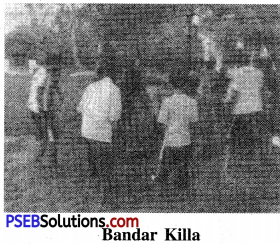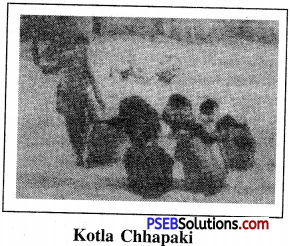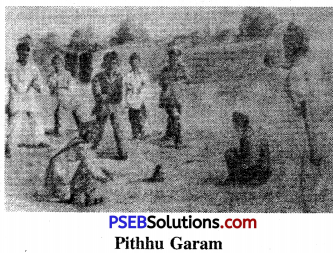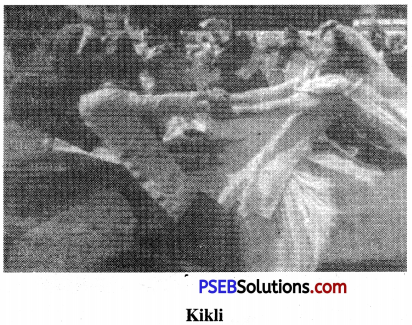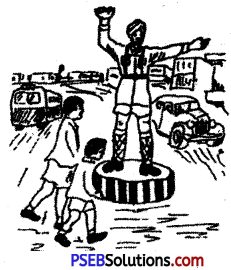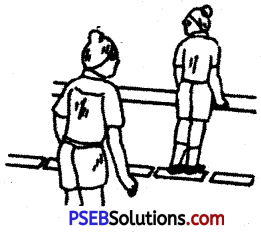Punjab State Board PSEB 6th Class Physical Education Book Solutions Chapter 8 Drug Addiction-A Curse Textbook Exercise Questions and Answers.
PSEB Solutions for Class 6 Physical Education Chapter 8 Drug Addiction-A Curse
Physical Education Guide for Class 6 PSEB Drug Addiction-A Curse Textbook Questions and Answers
Question 1.
Which intoxication eliminates the power of thinking and digestion of a person?
Answer:
Alcohol is an intoxicant that eliminates the power of thinking and digestion of a person. Alcohol affects the brain first of all. Nervous system gets affected and the brain weakens. The thinking power or faculty declines. With the effect of this intoxicant, respiration increases, and one suffers from diseases pertaining to respiratory system.
![]()
Question 2.
Which poisonous element is found in a cigarette?
Answer:
‘Nicotine’ is a poisonous element that is found in a cigarette. This is an alkaloid from tabacco plant. Nicotine has its adverse effect on the head which begins to feel giddy, and then the heart is badly affected. The possibility of suffering from cancer increases with the excessive use of tobacco, particularly the cancer of lungs and throat.
Question 3.
Write down the effects of Alcohol on our health.
Answer:
Effects of Alcohol on our Health:
Alcohol is a liquid intoxicant. It is legally binding to write on each bottle of alcohol-“Drinking is injurious to health.” Even then more and more people are becoming addict to alcohol, and seem to ignore the statutory warning totally. Thus, more and more such people are becoming prey to many diseases. Their lungs get defected. The liver is damaged. Age declines. Alcohol, in fact, adversely affects all parts of the body. At first man fakes alcohol, then alcohol begins to take (consume) him. Alcohol has several bad effects, some of which are listed below:
- Alcohol affects the brain first of all. Nervous system gets affected and the brain weakens. The thinking power or faculty declines.
- The kidneys in the body weaken.
- Alcohol becomes a hindrance in the production of digestive juices, as a result of which digestion becomes poor.
- Respiration increases, and one suffers from diseases pertaining to respiratory system.
- Blood vessels expand under the influence of regular drinking. Brain has to exert more, and one may suffer a heart attack any moment.
- Regular drinking decreases the work capacity of muscles, The body gets weak to face the attack of disease germs.
- The studies have revealed that a drunkard works less than a normal person. A drunkard also suffers from various diseases sooner than a normal individual.
- Drinking is a social evil as it ruins home, health and wealth.
Question 4.
What are the intoxicants that cause cancer?
Answer:
Cancer causes with the consuming of cigarettes, bidis, jarda, Kheni etc. These are made from tobacco.
Effects of Smoking on Health:
In our country smoking and consuming tobacco has become a habit and fashion. There are several ways to consume tobacco such as smoking cigarettes, bidis, cigars, hubble-bubble, etc. Tobacco is also eaten in many forms such as eating “paan”, tobacco mixed with lime, “jarda”, etc. There is a dangerous toxic substance; called nicotine in tobacco. There are other toxins like ammonia, carbon dioxide, etc. Nicotine has its adverse effect on the head which begins to feel giddy, and then the heart is badly affected.
The harms of tobacco on health are as under:
- Eating or taking tobacco weakens eyesight.
- It increases heart beat. One suffers from heart diseases which often prove fatal.
- Studies have revealed that tobacco consuming contracts blood vessels.
- Tobacco benumbs the body tissues. One does not have good sleep and ultimately suffers from sleeplessness.
- Stomach begins to remain upset with tobacco consumption.
- Tobacco also causes cough, and the consumer of tobacco is prone to lung diseases like T.B.
- The possibility of suffering from cancer increases with the excessive use of tobacco, particularly the cancer of lungs and throat.
![]()
Question 5.
What is the identity of the drug user in Society?
Answer:
Ever since time immemorial man has been using intoxicants. He was of the opinion that their use was helpful in removing some diseases and in making one feel fresh. But later on the harmful effects of intoxicants came to light. In today’s world, many types of intoxicants have come into use and are easily available. The sports world, in particular, feels concerned and worried. There is no doubt that man can work overtime by consuming some intoxicants, but in the long ran overwork results in his fast decay and death. Among these intoxicants some are worse than leprosy. Such intoxicants as alcohol, tobacco, opium, hashish, bhang, etc. are very harmful to one’s health.
The problem of drag addiction affects the drag user as well as his family and society. Drug user does not take interest in any kind of work. As a result he himself becomes a responsibility of the society and family. Nobody wants his friendship and respects him. It becomes more difficult for him to purchase costly drags daily. As a result he commits crimes to pay for his drags. Thus he loses his character and the relationship with
society becomes unhealthy.
PSEB 6th Class Physical Education Guide Drug Addiction-A Curse Important Questions and Answers
Multiple Choice Questions
Question 1.
Name four intoxicants:
(A) Alcohol
(B) Tobacco
(C) Bhang and Opium
(D) All above.
Answer:
(D) All above.
![]()
Question 2.
Name any two systems which are being affected by intoxicants?
(A) Digestive and circulatory system
(B) Mentle system
(C) Bone system
(D) None of them.
Answer:
(A) Digestive and circulatory system
(B) Mentle system
Question 3.
Write any harms of intoxicants on sports person.
(A) Carelessness
(B) Irresponsibility
(C) Headache
(D) None of them.
Answer:
(A) Carelessness
(B) Irresponsibility
Question 4.
Write measures to get rid of drag addiction.
(A) Motivation
(B) Conference
(C) Psychological method
(D) All above
Answer:
(D) All above.
Question 5.
Effects of smoking on health:
(A) The possibility of suffering from cancer.
(B) Tobacco is prone to lung diseases like T.B.
(C) Stomach begins to get weaker.
(D) All above.
Answer:
(D) All above.
Question 6.
Effects of alcohol on our health.
(A) Alcohol affects the brain.
(B) The kidneys in the body get weaker.
(C) Digestive system become poor.
(D) All above.
Answer:
(D) All above.
Very Short Answer Type Questions
Question 1.
Name any two systems which are being affected by intoxicants.
Answer:
Digestive system and circulatory system.
![]()
Question 2.
Write any two harms of intoxicants.
Answer:
- Face becomes pale.
- Disturbance of mental concentration.
Question 3.
Write any two harms of intoxicants on sportsperson.
Answer:
- Carelessness and irresponsibility.
- End of Sportsmanship
Question 4.
Alcohol affects brain. (Right or wrong)
Answer:
Right.
Question 5.
Chewing tobacoo causes weak eyesight. (Right or wrong)
Answer:
Right.
Question 6.
Smoking causes cancer or not.
Answer:
Causes cancer.
Question 7.
Use of Tobacco does not cause cough and the consumption of tobacco is not prone to T.B. (Right or wrong)
Answer:
Wrong.
Question 8.
Under the influence of intoxicants player become careless. (Right or wrong)
Answer:
Right.
![]()
Short Answer Type Questions
Question 1.
Prepare a list of some commonly used intoxicants.
Answer:
- Alcohol
- Bhang
- Caffeine
- Opium
- Hashish
- Ademwin
- Tobacco
- Snuff
- Kheni
- Cigarette
- Bidi
- Jarda.
Question 2.
What is the harmful effect of narcotics?
Answer:
Narcotic drugs weaken the human body and affects the mind also. The behaviour of the person seems out of control. This affects his personal and social life.
Question 3.
Write any two measures to get rid of drug addiction.
Answer:
1. Motivation: The parents, school teachers and elders of the family play an important role to motivate the children to avoid narcotics.
2. Psychological Method: If it seems difficult, then the person should be prepared to give up drugs with the counselling of a psychologist.
![]()
Question 4.
Why is it important to get rid from Drug addiction?
Answer:
Drugs have become a great problem in the society nowadays. Drugs affect the user’s body by weakening the digestive system, immune system, circulatory system, respiratory system, metabolism, nervous system, etc. The persistent use of drugs may cause many severe diseases such as hypertension, numbness, diabetes, jaundice, cancer, etc. The risk of heart related diseases also increases, hands start shaking, the person suffers mental imbalance as well.
Use of narcotic drugs affects the behaviour of the person very badly. He loses control over his senses and quarrels with people without any genuine reason. The drug addict remains irritated all the time as the narcotics severely affects all the systems of his body. People of the society avoid him which further adds to his irritation. So it is very important to get rid of drug addiction.

